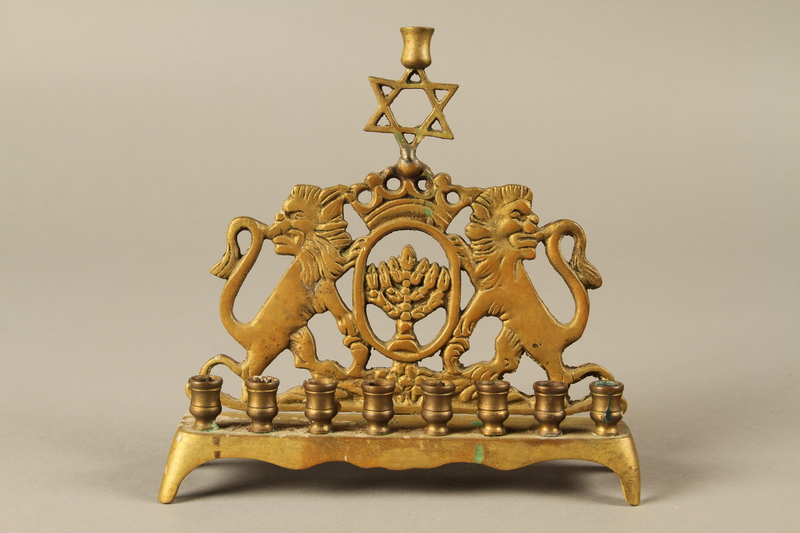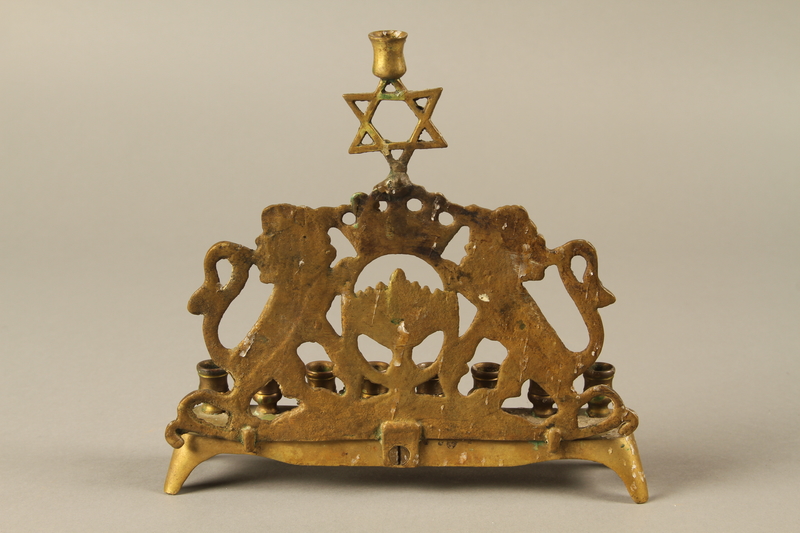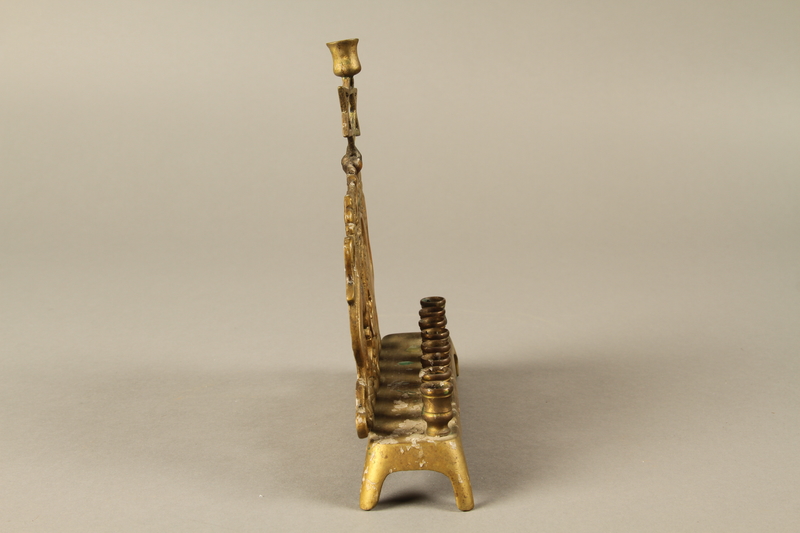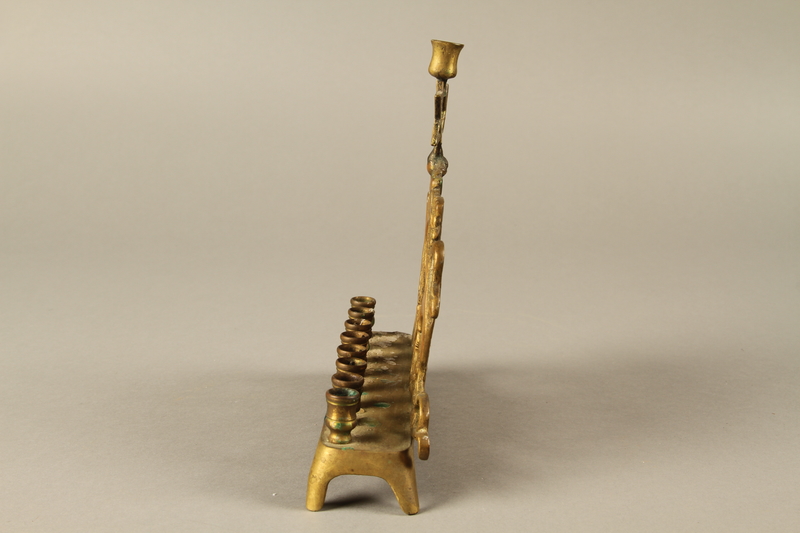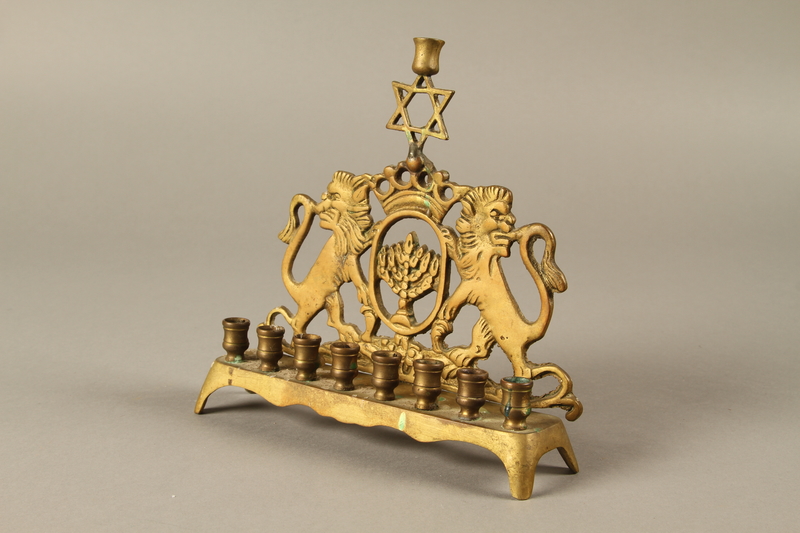Overview
- Brief Narrative
- Hanukiyah with rearing lions owned by holocaust survivor Herman Fayman. The 9-branched candelabrum is a hanukiyah or Hannukah lamp. A lamp is designed to hold eight candles for the eight nights of Hanukkah; the ninth candle is the Shamash [attendant] that is used to light the other candles. Traditionally, a menorah refers only to the original 7-branched lamp that stayed lit in the Temple. Herman was born in Pelizza (likely Pilica), Poland, in 1906. In September 1939, during the German invasion of Poland, Herman was serving in the Polish army when he was captured as a prisoner of war (POW). Herman was interned in a POW camp in Biała Podlaska, and then sent to the town of Sosnowitz (now Sosnowiec). He was transferred to Auschwitz concentration camp in March, 1941. After five months, he was sent to Kattowitz (now Katowice). Between 1942 until 1944, Herman was held in three forced labors camps: one in Faulbrück, (now Mościsko), one in Landeshut (now Kamienna Góra), and one in Annaberg, Germany (now, Góra Swietej Anny, Poland). In the late spring or early summer of 1944, Herman was deported to Auschwitz-Birkenau killing center in German-occupied Poland. On September 30, Herman was transferred to Buchenwald concentration camp in Germany, and then to one of its subcamps, Niederorschel, on October 30. In the spring of 1945, Herman escaped and went into hiding until American forces liberated the area. On February 21, 1947, Herman immigrated to the United States.
- Date
-
manufacture:
1900-1933
- Geography
-
manufacture:
United States
- Credit Line
- United States Holocaust Memorial Museum Collection, Gift of Anna Krosnecki
- Contributor
-
Original owner:
Herman Fayman
Subject: Herman Fayman
- Biography
-
Herman Fayman (1906-1986) was born in Pelizza Poland (likely Pilica, Poland), to Jewish parents, Moische and Sara (nee Pachter) Fayman. Jewish life in Pilica can be traced back continuously to the end of the 17th century, when the ban on Jewish residence in the town was lifted. The town was a center of Hasidism and had a majority Jewish population. Herman worked as a locksmith and a farmer, and before the war, he was a soldier in Krakow.
In September 1939, Germany invaded Poland. The country was quickly occupied, and Herman was among the large portion of Polish soldiers captured as prisoners of war (POWs). He was interned in a POW camp in German-occupied Biała Podlaska, along with 500 other Jewish POWs who arrived in early 1940. From Biała Podlaska, Herman was sent to the town of Sosnowitz (now Sosnowiec), where the Nazi authorities had taken away the Jewish population’s rights and isolated them from the rest of the population and the town’s economic life. In March, 1941, Herman was transported from Sosnowitz to Auschwitz concentration camp. He was placed in the main camp, where prisoners were used as forced laborers to expand the camp complex, which would eventually grow to include Auschwitz-Birkenau and Monowitz.
Herman remained in Auschwitz for five months before he was transported a few miles north, to Kattowitz (now Katowice) in September. In 1942, he was sent to Faulbrück forced labor camp, in Faulbrück, (now Mościsko) located in Lower Silesia. Faulbrück was a subcamp in the Gross-Rosen concentration camp system. In the summer of 1944, Herman was sent to a newly constructed forced labor subcamp of Gross-Rosen, in Landeshut (now Kamienna Góra). In the camp, prisoners were forced to manufacture roller and ball bearings. Herman was only in Landeshut for a short time before he was deported to a forced labor camp in Annaberg, Germany (now Góra Swietej Anny, Poland). The prisoners in the Annaberg camp were forced to do carpentry work for Altana carpentry, tailor uniforms for the Rosner Company, and work in the Oderthal-Werke, Graf Schaffgotsch synthetic gasoline factory. Herman was then sent to Auschwitz-Birkenau killing center in German-occupied Poland. Upon entry, Herman’s new prisoner number, B-10640, was tattooed on his left forearm. Based on his prisoner number, Herman arrived in Birkenau after May 1944. He was kept in block 11, a building where prisoners were jailed for offenses such as breaking camp regulations, attempting escape or aiding other prisoner’s escape attempts, suspected sabotage, and contact with civilians. The building also was also used for various types of torture on the prisoners by the guards. On September 30, 1944, Herman was transferred to block 41 in Buchenwald concentration camp. Upon entry, he used the name Hersch Fajmann, claimed his occupation was a hairdresser, and lied about his birthdate to make himself appear younger. He was assigned prisoner number 95636, and was sent to the Niederorschel forced labor camp, a subcamp of Buchenwald, in Niederorschel, Germany. Herman arrived at the subcamp on October 30, with a group of 282 prisoners who had been transferred from Auschwitz. In the camp, the prisoners were forced to work 12 hours days in the Junkers-Werke aircraft factory, making parts for the wings and undercarriages of the Focke-Wulf 190.
Herman remained in Niederorschel until 1945. Between the camp’s opening in September 1944, and its evacuation on April 1 and 2, 1945, approximately 130 prisoners escaped, including Herman. Many were aided and hidden by local villagers. Herman hid until the area was liberated by American troops. After the war, Herman was housed in displaced person’s (DP) camps in Holungen and Nordhausen, both in Germany. Later, he lived in a DP camp in Berlin until February 21, 1947, when he boarded the Marine Marlin and immigrated to the United States. He arrived in New York on March 3. On October 25, 1947, Herman married Jennie Hasman in New York.
Physical Details
- Classification
-
Jewish Art and Symbolism
- Category
-
Jewish ceremonial objects
- Object Type
-
Hanukkah lamp (lcsh)
- Genre/Form
- Menorahs.
- Physical Description
- Copper alloy menorah consisting of a rectangular base with a decorative back piece screwed on. The base is flat on top, with four short legs extending down and out, and wavy sides in-between the legs. There are eight, goblet shaped candle holders, evenly spaced in a line near the front edge. The back piece is attached to the rear of the base by a single screw in the center. The design consists of a centered 7-branched menorah inside an oblong frame with rearing lions flanking it, their faces turned outwards. Above the menorah is a crown with four holes at the top, and above that a Star of David. The top point of the star extends into a ninth goblet shaped candle holder. There is leftover wick inside each candleholder along the base. There is wax across the base, particularly on the left side, and across the very top. In some areas the wax and metal have turned green.
- Dimensions
- overall: Height: 7.250 inches (18.415 cm) | Width: 7.750 inches (19.685 cm) | Depth: 2.000 inches (5.08 cm)
- Materials
- overall : copper alloy, metal, wax, cotton
Rights & Restrictions
- Conditions on Access
- No restrictions on access
- Conditions on Use
- No restrictions on use
Keywords & Subjects
- Topical Term
- Escaped prisoners of war--Poland. Forced labor--Germany. Hanukkah lamp. Holocaust, Jewish (1939-1945)--Concentration camps. Holocaust, Jewish (1939-1945)--Germany. Holocaust, Jewish (1939-1945)--Poland. Jewish art and symbolism--21st century. Lion in art. Prisoner-of-war camps. United States--Emigration and immigration. World War, 1939-1945--Campaigns--Poland.
- Geographic Name
- Berlin (Germany) Biała Podlaska (Poland) Góra Świętej Anny (Poland) Kamienna Góra (Województwo Dolnośląskie, Poland) Katowice (Poland) New York (N.Y.) Niederorschel (Germany) Nordhausen (Thuringia, Germany) Oświęcim (Poland) Pilica (Poland) Silesia, Lower (Poland and Germany) Sosnowiec (Województwo Śląskie, Poland) Weimar (Thuringia, Germany)
- Corporate Name
- Annaberg (Concentration camp) Auschwitz (Concentration camp) Biala Podlaska (Concentration camp) Birkenau (Concentration camp) Buchenwald (Concentration camp) Faulbrück (Concentration camp) Gross-Rosen (Concentration camp) Landeshut (Concentration camp) Niederorschel (Concentration camp)
Administrative Notes
- Legal Status
- Permanent Collection
- Provenance
- The menorah was donated to the United States Holocaust Memorial Museum in 2014 by Anna Krosnecki, the daughter of Herman Fayman.
- Record last modified:
- 2022-07-28 21:51:16
- This page:
- https://collections.ushmm.org/search/catalog/irn550671
Also in Herman Fayman collection
The collection consists of a concentration camp uniform cap, jacket, and pants, a menorah, documents, and photographs relating to the experiences of Herman Fayman in Auschwitz concentration camp during the Holocaust and in the United States after the Holocaust.
Date: 1940-1963
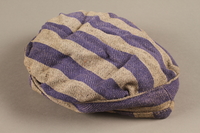
Concentration camp uniform cap worn by a Polish Jewish prisoner who was in several camps
Object
Striped uniform cap worn by Herman Fayman while he was a prisoner at Buchenwald concentration camp and its subcamp, Niederorschel forced labor camp in Germany, from September 1944 to spring 1945. Herman was born in Pelizza (likely Pilica), Poland, in 1906. In September 1939, during the German invasion of Poland, Herman was serving in the Polish army when he was captured as a prisoner of war (POW). Herman was interned in a POW camp in Biała Podlaska, and then sent to the town of Sosnowitz (now Sosnowiec). He was transferred to Auschwitz concentration camp in March, 1941. After five months, he was sent to Kattowitz (now Katowice). Between 1942 until 1944, Herman was held in three forced labors camps: one in Faulbrück, (now Mościsko), one in Landeshut (now Kamienna Góra), and one in Annaberg, Germany (now, Góra Swietej Anny, Poland). In the late spring or early summer of 1944, Herman was deported to Auschwitz-Birkenau killing center in German-occupied Poland. On September 30, Herman was transferred to Buchenwald concentration camp in Germany, and then to one of its subcamps, Niederorschel, on October 30. In the spring of 1945, Herman escaped and went into hiding until American forces liberated the area. On February 21, 1947, Herman immigrated to the United States.
Herman Fayman collection
Document
Photographs and documents relating to Herman Fayman (donor's father). Herman Fayman was born in 1906 in Pelizza, Poland and was deported from Sosnowitz, Poland to the Auschwitz-Birkenau killing center and subsequent concentration camps in Germany. He survived and immigrated to the United States in 1947.
Concentration camp uniform pants worn by a Polish Jewish prisoner who was in several camps
Object
Striped uniform pants worn by Herman Fayman while he was a prisoner at Buchenwald concentration camp and its subcamp, Niederorschel forced labor camp in Germany, from September 1944 to spring 1945. Herman was born in Pelizza (likely Pilica), Poland, in 1906. In September 1939, during the German invasion of Poland, Herman was serving in the Polish army when he was captured as a prisoner of war (POW). Herman was interned in a POW camp in Biała Podlaska, and then sent to the town of Sosnowitz (now Sosnowiec). He was transferred to Auschwitz concentration camp in March, 1941. After five months, he was sent to Kattowitz (now Katowice). Between 1942 until 1944, Herman was held in three forced labors camps: one in Faulbrück, (now Mościsko), one in Landeshut (now Kamienna Góra), and one in Annaberg, Germany (now, Góra Swietej Anny, Poland). In the late spring or early summer of 1944, Herman was deported to Auschwitz-Birkenau killing center in German-occupied Poland. On September 30, Herman was transferred to Buchenwald concentration camp in Germany, and then to one of its subcamps, Niederorschel, on October 30. In the spring of 1945, Herman escaped and went into hiding until American forces liberated the area. On February 21, 1947, Herman immigrated to the United States.
Concentration camp uniform jacket worn by a Polish Jewish prisoner who was in several camps
Object
Striped uniform jacket worn by Herman Fayman while he was a prisoner at Buchenwald concentration camp and its subcamp, Niederorschel forced labor camp in Germany, from September 1944 to spring 1945. Herman was born in Pelizza (likely Pilica), Poland, in 1906. In September 1939, during the German invasion of Poland, Herman was serving in the Polish army when he was captured as a prisoner of war (POW). Herman was interned in a POW camp in Biała Podlaska, and then sent to the town of Sosnowitz (now Sosnowiec). He was transferred to Auschwitz concentration camp in March, 1941. After five months, he was sent to Kattowitz (now Katowice). Between 1942 until 1944, Herman was held in three forced labors camps: one in Faulbrück, (now Mościsko), one in Landeshut (now Kamienna Góra), and one in Annaberg, Germany (now, Góra Swietej Anny, Poland). In the late spring or early summer of 1944, Herman was deported to Auschwitz-Birkenau killing center in German-occupied Poland. On September 30, Herman was transferred to Buchenwald concentration camp in Germany, and then to one of its subcamps, Niederorschel, on October 30. In the spring of 1945, Herman escaped and went into hiding until American forces liberated the area. On February 21, 1947, Herman immigrated to the United States.

